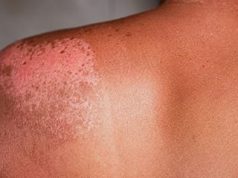Surface area of 25 cm2 or more, involvement of three or more locations linked to increased risk
THURSDAY, June 17, 2021 (HealthDay News) — Factors associated with higher and lower risk of posterior fossa malformations, hemangioma, arterial anomalies, cardiac defects, eye anomalies (PHACE) syndrome have been identified in children with infantile hemangiomas, according to a study published online June 16 in JAMA Dermatology.
Colleen H. Cotton, M.D., from the University of Arizona in Tucson, and colleagues conducted a multicenter, retrospective cohort study involving all patients with a facial, head, and/or neck infantile hemangioma who were evaluated for PHACE syndrome from Aug. 1, 2009, to Dec. 31, 2014, at 13 pediatric dermatology referral centers. A total of 238 patients were included in the analysis: 106 (44.5 percent) met the criteria for definite or possible PHACE syndrome (98 and eight, respectively).
The researchers found that statistically significant risk factors for PHACE syndrome included a surface area of 25 cm2 or more and involvement of three or more locations (odds ratios, 2.99 and 17.96, respectively). Lower risk was seen in association with involvement of the parotid gland and segment S2 (odds ratios, 0.39 and 0.38, respectively). Race and ethnicity may be associated with PHACE syndrome.
“More studies are needed to better delineate the association of PHACE syndrome with race and ethnicity,” the authors write. “This knowledge can guide practitioners in evaluation and treatment of these patients.”
Several authors disclosed financial ties to the biopharmaceutical, nutrition, and medical technology industries.
Abstract/Full Text (subscription or payment may be required)
Copyright © 2021 HealthDay. All rights reserved.








